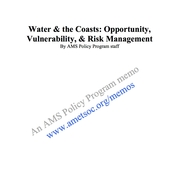By AMS Policy Program Staff ([email protected])
The views expressed in American Meteorological Society Policy Program memos are those of the author alone and do not necessarily reflect the views of the American Meteorological Society, its members, or sponsors.
Water is simultaneously a resource and a threat. It is centrally important to every aspect of socioeconomic wellbeing and water becomes a hazard when there is too much, too little, or if the quality is poor. The opportunities and challenges posed by water are especially acute at the coasts, which are both major resources and often highly vulnerable to extreme events. Coastal communities are also particularly sensitive to changes in land use, population distributions, and climate.
This memo identifies seven ways to enhance coastal risk management: 1) provide actionable information; 2) prepare and empower information users; 3) create decision support products and services that harness scientific advances for societal benefit; 4) build strong partnerships among stakeholders, practitioners, and information providers; 5) develop the next generation workforce; 6) align roles and responsibilities; and 7) recognize linkages and potential leverage.
Provide Actionable Information (observations, science, and forecasts)
Observational infrastructure; science (research, data assimilation, and models); and computational capabilities determine the accuracy of weather and water forecasts and provide the foundational information needed for risk management. Forecasts of water quantity and quality are most useful when they account for all sources of water (e.g., precipitation, tides, waves, sea level, and storm surge) and factors that affect water’s behavior (e.g., land use and infrastructure).
Efforts to fill in observational gaps near the coasts and to improve the interoperability of different modeling approaches (e.g., river forecast, wave, ice, estuarine hydrodynamic, and storm surge models) have great potential to improve informational resources. Greater understanding of the linkages among the physical climate system, biological resources, and socioeconomic wellbeing would facilitate decision making and is possible through improved integration of physical, natural, and social sciences.
Prepare and Empower Information Users
When equipped to use information effectively, stakeholders, emergency managers, policy makers, the media, and the public make better decisions. We can recognize coastal vulnerabilities, effectively weigh options for risk management, and know how to respond when confronting hazards. However, influxes of people and turnover among coastal populations ensure that efforts to prepare and empower information users must be ongoing. Similarly, long periods of time between high impact events leads to complacency and requires strategies for ensuring that people know how to respond when hazards arise.
Formal education (pre-K through college and graduate training) and informal outreach to groups and individuals can help communities take up and use information effectively. These efforts will be most useful when grounded in insights from social sciences, particularly research on how to engage effectively (e.g., with stakeholders, emergency managers and other practitioners, information users, policy makers, the media, and the public) and to enhance risk communication.
Create Services & Decision Support Products that Harness Scientific Advances for Societal Benefit
Products and services that are accessible and tailored to specific user needs are easier to integrate into risk management decisions. Big data and data analytics offer new opportunities to create decision support products and enhanced risk management services. Data accessibility and ease-of-use among information providers and users improves the uptake and use of information.
Build Strong Partnerships Among Information Providers, Users, and Stakeholders
There is a need for strong, sustained networks of connected partners working together across federal agencies and among local, regional, and federal organizations and stakeholders. Institutionalizing key relationships can overcome the risk of turnover within agencies and among experts and service providers. Efforts to manage risks and water resources have the best chance of success when stakeholders understand differing perspectives and work to identify shared values that can be advanced together.
Develop the Next Generation Workforce
Improving risk management over time will depend on providing scientists and practitioners with the knowledge, skills, and abilities (KSAs) needed most. Expertise in probabilistic modeling; stakeholder engagement; risk communication; integrated risk assessment; data analytics; and the integration of the physical, natural, and social sciences, among other KSAs, are likely to be particularly useful in the future.
Align Roles and Responsibilities
Conflicts arise among users who are separated across local, state, and federal jurisdictions. Suboptimal allocations of resources can occur when decision-making responsibilities are narrowly focused, and efforts to deal with a problem at one scale can create new problems at other locations or scales. This creates a need for aligning responsibilities and jurisdictions, and setting the appropriate spatial scales for management. Regional and national coordination is needed for issues that exceed local jurisdictions.
Federal roles with respect to water resource management may include: providing information and services; setting of standards; identifying best practices; providing a repository of case studies and/or lessons learned; helping to ensure and enhance public goods; regulation; and the provision of resources to local and regional efforts. Federal efforts that apply to diverse local communities have greater chance of widespread adoption and success. Effective collaboration among the critical federal agencies (NOAA, USGS, NASA, EPA, and FEMA, among others) also enhances coastal risk management.
Determining public, private, and academic roles; adapting those roles as needs and capabilities shift over time; and facilitating collaboration among the public, private, and academic sectors will be critical for enhancing risk assessment and management efforts.
Recognize Linkages and Potential Leverage
Efforts to address coastal vulnerabilities can, at times, contribute to other priorities. Coastal risk management projects that achieve multiple goals may be more appealing to local communities and policy makers. For example, green infrastructure to mitigate coastal flooding may also provide fisheries habitat and recreational assets. The United States can both learn from other countries and share our resources and information with other countries (e.g., identify common needs, case studies, and lessons learned).
This AMS Policy Program memo is adapted from:
